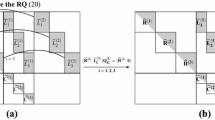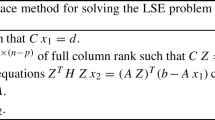Abstract
Algorithms for computing the three-stage least squares (3SLS) estimator usually require the disturbance convariance matrix to be non-singular. However, the solution of a reformulated simultaneous equation model (SEM) results into the redundancy of this condition. Having as a basic tool the QR decomposition, the 3SLS estimator, its dispersion matrix and methods for estimating the singular disturbance covariance matrix and derived. Expressions revealing linear combinations between the observations which become redundant have also been presented. Algorithms for computing the 3SLS estimator after the SEM have been modified by deleting or adding new observations or variables are found not to be very efficient, due to the necessity of removing the endogeneity of the new data or by re-estimating the disturbance covariance matrix. Three methods have been described for solving SEMs subject to separable linear equalities constraints. The first method considers the constraints as additional precise observations while the other two methods reparameterized the constraints to solve reduced unconstrained SEMs. Method for computing the main matrix factorizations illustrate the basic principles to be adopted for solving SEMs on serial or parallel computers.
Similar content being viewed by others
References
Anderson, E., Bai, Z. and Dongarra, J. (1992). Generalized QR factorization and its applications, Linear Algebra and its Applications, 162, 243-271.
Barlow, J. and Handy, S. (1988). The direct solution of weighted and equality constrained least-squares problems, SIAM Journal of Scientific and Statistical Computing, 9(4), 704-716.
Belsley, D. (1992). Paring 3SLS calculations down to manageable proportions, Computer Science in Economics and Management, 5, 157-169.
Bjorck, A. (1984). A general updating algorithm for constrained linear least squares problems, SIAM Journal of Scientific and Statistical Computing, 5(2), 394-402.
Clint, M., Kontoghiorghes, E. and Weston, J. (1996). Parallel Gram-Schmidt orthogonalisation and QR factorisation on an array processor, Zeitschrift für Angewandte Mathematik und Mechanik (ZAMM), 76(S1), 377-378.
Court, R. (1974). Three stage least squares and some extensions where the structural disturbance covariance matrix may be singular, Econometrica, 42(3), 547-558.
Dent, W. (1976). Information and computation in simultaneous equation estimation, Journal of Econometrics, 4, 89-95.
Elden, L. and Park, H. (1994). Block downdating of least squares solutions, SIAM Journal of Matrix Analysis and Applications, 15(3), 1018-1034.
Gill, P., Golub, G., Murray, W. and Saunders, M. (1974). Methods for modifying matrix factorizations, Mathematics of Computation, 28(126), 505-535.
Golub, G. and Loan, C.V. (1983). Matrix Computations. North Oxford Academic.
Hammarling, S., Long, E. and Martin, P. (1983). A Generalized Linear Least Squares Algorithm for Correlated Observations, with Special Reference to Degenerate Data. DITC 33/83, National Physical Laboratory.
Jennings, L. (1980). Simultaneous equations estimation (computational aspects), Journal of Econometrics, 12, 23-39.
Judge, G., Griffiths, W., Hill, R., Lütkepohl, H. and Lee, T. (1985). The Theory and Practise of Econometrics. Wiley series in probability and mathematical statistics. John Wiley and Sons, second edition.
Kontoghiorghes, E. (1993a). Algorithms for Linear Model Estimation on Massively Parallel Systems. PhD Thesis, University of London. (Also Technical report TR-655, Department of Computer Science, Queen Mary and Westfield College, University of London).
Kontoghiorghes, E. (1993b). Solving Seemingly Unrelated Regression Equations Models using Orthogonal Decompositions. Technical Report TR-631, Department of Computer Science, Queen Mary and Westfield College, University of London.
Kontoghiorghes, E. (1995). New parallel strategies for block updating the QR decomposition, Parallel Algorithms and Applications, 5(1 + 2), 229-239.
Kontoghiorghes, E. and Clarke, M. (1993a). Parallel reorthogonalization of the QR decomposition after deleting columns, Parallel Computing, 19(6), 703-707.
Kontoghiorghes, E. and Clarke, M. (1993b). Solving the updated and downdated ordinary linear model on massively parallel SIMD systems, Parallel Algorithms and Applications, 1(2), 243-252.
Kontoghiorghes, E. and Clarke, M. (1994). A parallel algorithm for repeated processing estimation of linear models with equality constraints. In: G. Joubert, D. Trystram, and F. Peters (eds): Parallel Computing: Trends and Applications, pp. 525-528.
Kontoghiorghes, E. and Clarke, M. (1995a). An alternative approach for the numerical solution of seemingly unrelated regression equation models, Computational Statistics & Data Analysis, 19(4), 369-377.
Kontoghiorghes, E. and Clarke, M. (1995b). Solving the general linear model on a SIMD array processor, Computers and Artificial Intelligence, 14(4), 353-370.
Kontoghiorghes, E. and Dinenis, E. (1996a). Data parallel QR decompositions of a set of equal size matrices used in SURE model estimation, Journal of Mathematical Modelling and Scientific Computing, 6. (In press).
Kontoghiorghes, E. and Dinenis, E. (1996b). Solving triangular seemingly unrelated regression equation models on massively parallel systems. In: M. Gilli (ed.): Computational Economic Systems: Models, Methods & Econometrics, Vol. 5 of Advances in Computational Economics. pp. 191-201.
Kourouklis, S. and Paige, C. (1981). A constrained least squares approach to the general Gauss-Markov linear model, Journal of the American Statistical Association, 76(375), 620-625.
Lawson, C. and Hanson, R. (1974). Solving Least Squares Problems. Prentice-Hall Englewood Cliffs.
De Moor, B. and Van Dooren, P. (1992). Generalizations of the singular value and QR decompositions, SIAM Journal of Matrix Analysis and Applications, 13(4), 993-1014.
Narayanan, R. (1969). Computation of Zellner-Theil's three stage least squares estimates, Econometrica, 37(2), 298-306.
Olszanskyj, S., Lebak, J. and Bojanczyk, A. (1994). Rank-κ modification methods for recursive least squares problems, Numerical Algorithms, 7, 325-354.
Paige, C. (1978). Numerically stable computations for general univariate linear models, Communications on Statistical and Simulation Computation, 7(5), 437-453.
Paige, C. (1979a). Computer solution and perturbation analysis of generalized linear least squares problems, Mathematics of Computation, 33(145), 171-183.
Paige, C. (1979b). Fast numerically stable computations for generalized linear least squares problems, SIAM Journal of Numerical Analysis, 16(1), 165-171.
Paige, C. (1990). Some aspects of generalized QR factorization. In: M. Cox and S. Hammarling (eds): Reliable Numerical Computations.
Pollock, D. (1979). The Algebra of Econometrics, Wiley series in probability and mathematical statistics. John Wiley and Sons.
Sargan, D. (1988). Lectures on Advanced Econometric Theory. Basil Blackwell Inc.
Schittkowski, K. and Stoer, J. (1979). A factorization method for the solution of constrained linear least squares problems allowing subsequent data changes, Numerische Mathematik, 31, 431-463.
Srivastava, V. and Tiwari, R. (1978). Efficiency of two-stage and three-stage least squares estimators, Econometrica, 46(6), 1495-1498.
Stoer, J. (1971). On the numerical solution of constrained least-squares problems, SIAM Journal of Numerical Analysis, 8(2), 382-411.
Theil, H. (1971). Principles of Econometrics. John Wiley & Sons, Inc.
Zellner, A. and Theil, H. (1962). Three-stage least squares: Simultaneous estimation of simultaneous equations, Econometrica, 30(1), 54-78.
Author information
Authors and Affiliations
Corresponding author
Rights and permissions
About this article
Cite this article
KONTOGHIORGHES, E.J., DINENIS, E. Computing 3SLS Solutions of Simultaneous Equation Models with a Possible Singular Variance–Convariance Matrix. Computational Economics 10, 231–250 (1997). https://doi.org/10.1023/A:1008617207791
Issue Date:
DOI: https://doi.org/10.1023/A:1008617207791




